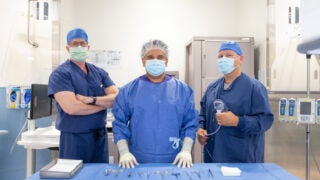
In an ambitious new study at ISI, researchers are developing predictive models to better understand the evolving relationship between humans and the environment, such as the impact of river dams on surrounding communities and ecosystems.(Photo/iStock)
Researchers at USC’s Information Sciences Institute use AI to model the world
A $13 million DARPA award allows study of how the evolving relationship between humans and nature impacts the planet
Researchers at the USC Viterbi School of Engineering’s Information Sciences Institute are leveraging artificial intelligence to create an ambitious new computer modeling and predictive analysis tool thanks to a new $13 million Defense Advanced Research Projects Award (DARPA) award.
Principal investigator Yolanda Gil, an institute research director and USC Viterbi computer science professor, and a team of scientists and researchers are developing a tool to better understand how the evolving relationship between humans and nature impacts the planet.
DARPA and artificial intelligence
The four-year project — called MINT, for Model INTegration — is part of DARPA’s World Modelers program.
Using artificial intelligence techniques, the system will combine existing models from various disciplines — including hydrology, agriculture, economics and social sciences — and run simulations to predict the consequences of actions or policies in specific geographic regions. For instance, what could be the social and economic impacts of dam construction on fisheries and crop production?
The project’s co-principal investigators are institute researchers and USC Viterbi faculty members Ewa Deelman, a research professor of computer science; Rafael Ferreira da Silva, a computer science research assistant professor; and Craig Knoblock, a computer science research professor.
The science of prediction
While big data collection is becoming an increasingly automated process, complex world models are still pieced together by hand. This is a particularly challenging task, since many problems require the integration of models from different fields with diverse modeling approaches. In fact, analyzing just one scenario in this way can take up to two years. Using automation and artificial intelligence, Gil and her team hope to bring that down to a couple of days.
The team includes researchers from Virginia Tech, The Pennsylvania State University, the University of Minnesota and the University of Colorado.
Comprehensive approach
Building on group’s extensive prior work on model integration both from disciplinary and computational perspectives, the researchers have proposed a comprehensive approach, which includes cross-disciplinary modeling, model integration, workflow composition and execution, data extraction and data integration.
We use AI to process and describe the data and information in a very precise way.
Yolanda Gil
“We use AI to process and describe the data and information in a very precise way,” said Gil, who leads ISI’s Interactive Knowledge Capture Group.
“We develop ontologies to describe specific terms and knowledge graphs to help us relate those terms to others. Then, we apply machine learning algorithms to refine the data and workflow tools to track the data flow through the software. The output is the prediction, for example, water availability in a specific region.”
Modeling experts will provide test scenarios, as well as data sources and models, including data extracted from remote Earth observation. The team plans to open-source the MINT software to create a community of users that will continue to use and develop the software over time.
“Ultimately, by developing this sophisticated modeling environment, MINT aims to significantly reduce the time needed to develop new integrated models,” said Gil. “We hope to generate a better understanding of how human and natural processes impact one another. That’s the holy grail.”



